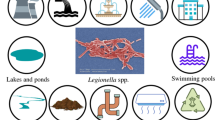Abstract
When a sensitive host inhales aerosols containing these bacteria, Legionella infection occurs. Therefore, monitoring and assessing Legionella in the environment and water distribution systems of such places are critical due to the prone population in hospitals. However, the health risks of Legionella bacteria in the environment are not adequately evaluated. In this study, for hospitalized patients, we performed a quantitative health risk assessment of Legionella in selected hospitals in Tehran city using two scenarios of shower and toilet faucet exposure. This study identified Legionella in 38 cases (38%) out of 100 samples collected from toilet faucets and showers in 8 hospitals. The information gathered was used for quantitative microbial risk assessment (QMRA). The microbial load transmitted by inhalation was calculated using the concentration of Legionella in water. Other exposure parameters (inhalation rate and exposure time) were obtained using information from other studies and the median length of hospital stay (3.6 days). The exponential model was used to estimate the risk of infection (γ = 0.06) due to Legionella pneumophila (L. pneumophila) inhalation for each exposure event. For the mean concentration obtained for Legionella (103 CFU/L), the risk of infection for toilet faucets and showers was in the range of 0.23–2.3 and 3.5–21.9, respectively, per 10,000 hospitalized patients. The results were compared with the tolerable risk level of infection determined by the US EPA and WHO. The risk values exceeded the WHO values for waterborne pathogens in hospitals in both exposure scenarios. As a result, our QMRA results based on monitoring data showed that despite using treated water (from distribution networks in the urban areas) by hospitals, 38% of the samples were contaminated with Legionella, and faucets and showers can be sources of Legionella transmission. Hence, to protect the health of hospitalized patients, the risk of Legionella infection should be considered.




Similar content being viewed by others
Data availability
This published article contains all of the data that was created or analyzed during this article.
References
Armstrong, T. W., & Haas, C. N. (2007a). A quantitative microbial risk assessment model for Legionnaires’ disease: Animal model selection and dose-response modeling. Risk Analysis, 27(6), 1581–1596. https://doi.org/10.1111/j.1539-6924.2007.00990.x
Armstrong, T. W., & Haas, C. N. (2007b). Quantitative microbial risk assessment model for Legionnaires’ disease: Assessment of human exposures for selected spa outbreaks. Journal of Occupational and Environmental Hygiene, 4(8), 634–646. https://doi.org/10.1080/15459620701487539
Azuma, K., Uchiyama, I., & Okumura, J. (2013). Assessing the risk of Legionnaires’ disease: The inhalation exposure model and the estimated risk in residential bathrooms. Regulatory Toxicology and Pharmacology, 65(1), 1–6. https://doi.org/10.1016/j.yrtph.2012.11.003
Bargellini, A., Marchesi, I., Righi, E., Ferrari, A., Cencetti, S., Borella, P., & Rovesti, S. (2011). Parameters predictive of Legionella contamination in hot water systems: Association with trace elements and heterotrophic plate counts. Water Research, 45(6), 2315–2321. https://doi.org/10.1016/j.watres.2011.01.009
Baskerville, A. (1981). Mechanisms of infection in the respiratory tract. New Zealand Veterinary Journal, 29(12), 235–238. https://doi.org/10.1080/00480169.1981.34852
Bavari, S., Mirkalantari, S., Masjedian Jazi, F., Darban-Sarokhalil, D., & Golnari Marani, B. (2022). Risk assessment and quantitative measurement along with monitoring of Legionella in hospital water sources. New Microbes and New Infections, 45, 100948. https://doi.org/10.1016/j.nmni.2021.100948
Bentham, R., & Whiley, H. (2018). Quantitative microbial risk assessment and opportunist waterborne infections–are there too many gaps to fill? International Journal of Environmental Research and Public Health, 15(6), 1150.
Best, M., Stout, J., Muder, R., Yu, V., Goetz, A., & Taylor, F. (1983). Legionellaceae in the hospital water-supply: Epidemiological link with disease and evaluation of a method for control of nosocomial Legionnaires’ disease and Pittsburgh Pneumonia. The Lancet, 322(8345), 307–310. https://doi.org/10.1016/S0140-6736(83)90290-8
Blanky, M., Sharaby, Y., Rodríguez-Martínez, S., Halpern, M., & Friedler, E. (2017). Greywater reuse - assessment of the health risk induced by Legionella pneumophila. Water Research, 125, 410–417. https://doi.org/10.1016/j.watres.2017.08.068
Bollin, G., Plouffe, J., Para, M. F., & Hackman, B. (1985). Aerosols containing Legionella pneumophila generated by shower heads and hot-water faucets. Applied and Environmental Microbiology, 50(5), 1128–1131.
Borchgrevink, C. P., Cha, J., & Kim, S. (2013). Hand washing practices in a college town environment. Journal of Environmental Health, 75(8), 18–25.
Buse, H. Y., Schoen, M. E., & Ashbolt, N. J. (2012). Legionellae in engineered systems and use of quantitative microbial risk assessment to predict exposure. Water Research, 46(4), 921–933. https://doi.org/10.1016/j.watres.2011.12.022
Busgang, A., Friedler, E., Gilboa, Y., & Gross, A. (2018). Quantitative microbial risk analysis for various bacterial exposure scenarios involving greywater reuse for irrigation. Water, 10(4), 413.
Carducci, A., Donzelli, G., Cioni, L., Federigi, I., Lombardi, R., & Verani, M. (2018). Quantitative microbial risk assessment for workers exposed to bioaerosol in wastewater treatment plants aimed at the choice and setup of safety measures. International Journal of Environmental Research and Public Health, 15(7), 1490.
Crimi, P., Macrina, G., Grieco, A., Tinteri, C., Copello, L., Rebora, D., & Rizzetto, R. (2017). Correlation between legionella contamination in water and surrounding air. Infection Control & Hospital Epidemiology, 27(7), 771–773. https://doi.org/10.1086/504446
David, S., Afshar, B., Mentasti, M., Ginevra, C., Podglajen, I., Harris, S. R., & Parkhill, J. (2017). Seeding and establishment of Legionella pneumophila in hospitals: Implications for genomic investigations of nosocomial Legionnaires’ disease. Clinical Infectious Diseases, 64(9), 1251–1259. https://doi.org/10.1093/cid/cix153
De Filippis, P., Mozzetti, C., Messina, A., & D’Alò, G. L. (2018). Data on Legionella prevalence and water quality in showers of retirement homes and group homes in the Province of Rome, Lazio Region, Italy. Data in Brief, 19, 2364–2373. https://doi.org/10.1016/j.dib.2018.07.026
Dennis, P. J. L., Wright, A. E., Rutter, D. A., Death, J. E., & Jones, B. P. C. (2009). Legionella pneumophila in aerosols from shower baths. Journal of Hygiene, 93(2), 349–353. https://doi.org/10.1017/S0022172400064901
EPA, US. (2011). Exposure factors handbook 2011 Edition (Final Report). US Environmental Protection Agency, Washington, DC, EPA/600/R-09/052F.
EPA, US. (2007a). Thesaurus of terms used in microbiological risk assessment (p. 208). US EPA.
EPA, US. The United States Environmental Protection Agency. (2007b). METHOD 6010C: inductively coupled plasma-atomic emission spectrometry, 3.
Eslami, A., Momayyezi, M. H., Esmaili, D., & Joshani, G. H. (2012). Presence of Legionella Pneumophila and environmental factors affecting its growth, in the water distribution system in Taleghani hospital, Tehran. Pajoohande, 17(1), 32–37.
Hamilton, K. A., Hamilton, M. T., Johnson, W., Jjemba, P., Bukhari, Z., LeChevallier, M., & Gurian, P. L. (2019). Risk-based critical concentrations of Legionella pneumophila for indoor residential water uses. Environmental Science and Technology, 53(8), 4528–4541. https://doi.org/10.1021/acs.est.8b03000
Hautemaniere, A., Remen, T., Mathieu, L., Deloge-Abarkan, M., Hartemann, P., & Zmirou-Navier, D. (2011). Pontiac fever among retirement home nurses associated with airborne legionella. Journal of Hospital Infection, 78(4), 269–273. https://doi.org/10.1016/j.jhin.2011.03.022
Hines, S. A., Chappie, D. J., Lordo, R. A., Miller, B. D., Janke, R. J., Lindquist, H. A., & Taft, S. C. (2014). Assessment of relative potential for Legionella species or surrogates inhalation exposure from common water uses. Water Research, 56, 203–213. https://doi.org/10.1016/j.watres.2014.02.013
ISO. (1998). ISO 11731:1998 Water quality - Detection and enumeration of Legionella. International Organization for Standardization.
ISO. (2006). ISO 19458:2006 Water quality - sampling for microbiological analysis. International Organization for Standardization.
Khaledi, A., Esmaeili, S.-A., Vazini, H., Karami, P., Bahrami, A., & Sahebkar, A. (2019). Evaluation of the prevalence of Legionella pneumophila in Iranian clinical samples: A systematic review and meta-analysis. Microbial Pathogenesis, 129, 93–98. https://doi.org/10.1016/j.micpath.2019.02.008
Kirby, B. D., Snyder, K. M., Meyer, R. D., & Finegold, S. M. (1980). Legionnaires’ disease: Report of sixty-five nosocomially acquired cases of review of the literature. Medicine, 59(3), 188–205.
Leoni, E., & Legnani, P. P. (2001). Comparison of selective procedures for isolation and enumeration of Legionella species from hot water systems. Journal of Applied Microbiology, 90(1), 27–33. https://doi.org/10.1046/j.1365-2672.2001.01178.x
Mayer, P., DeOreo, W., Opitz, E., Kiefer, J., Davis, W., Dziegielewski, B., & Nelson, J. (1999). Residential end uses of water. Aquacraft, Inc.
Montagna, M. T., Cristina, M. L., De Giglio, O., Spagnolo, A. M., Napoli, C., Cannova, L., & Pasquarella, C. (2016). Serological and molecular identification of Legionella spp. isolated from water and surrounding air samples in Italian healthcare facilities. Environmental Research, 146, 47–50. https://doi.org/10.1016/j.envres.2015.12.015
Mosadeghrad, A. M., & Esfahani, P. (2019). Patients’ unnecessary length of stay in Iran: A systematic review and meta-analysis. Jundishapur Scientific Medical Journal, 17(5), 529–544. https://doi.org/10.22118/jsmj.2019.148221.1457
Muchesa, P., Leifels, M., Jurzik, L., Barnard, T. G., & Bartie, C. (2018). Detection of amoeba-associated Legionella pneumophila in hospital water networks of Johannesburg. Southern African Journal of Infectious Diseases, 33(3), 72–75. https://doi.org/10.1080/23120053.2018.1434060
Parr, A., Whitney, E. A., & Berkelman, R. L. (2015). Legionellosis on the rise: A review of guidelines for prevention in the United States. Journal of Public Health Management and Practice, 21(5).
Pepper, I. L., & Gerba, C. P. (2018). Risk of infection from Legionella associated with spray irrigation of reclaimed water. Water Research, 139, 101–107. https://doi.org/10.1016/j.watres.2018.04.001
Sánchez-Parra, B., Núñez, A., & Moreno, D. A. (2019). Preventing legionellosis outbreaks by a quick detection of airborne Legionella pneumophila. Environmental Research, 171, 546–549. https://doi.org/10.1016/j.envres.2019.01.032
Schoen, M. E., & Ashbolt, N. J. (2011). An in-premise model for Legionella exposure during showering events. Water Research, 45(18), 5826–5836. https://doi.org/10.1016/j.watres.2011.08.031
Schwake, D. O., Alum, A., & Abbaszadegan, M. (2015). Impact of environmental factors on Legionella populations in drinking water. Pathogens, 4(2), 269–282.
Sharaby, Y., Rodríguez-Martínez, S., Höfle, M. G., Brettar, I., & Halpern, M. (2019). Quantitative microbial risk assessment of Legionella pneumophila in a drinking water supply system in Israel. Science of the Total Environment, 671, 404–410. https://doi.org/10.1016/j.scitotenv.2019.03.287
Vincenti, S., de Waure, C., Raponi, M., Teleman, A. A., Boninti, F., Bruno, S., & Laurenti, P. (2019). Environmental surveillance of Legionella spp. colonization in the water system of a large academic hospital: Analysis of the four–year results on the effectiveness of the chlorine dioxide disinfection method. Science of the Total Environment, 657, 248–253. https://doi.org/10.1016/j.scitotenv.2018.12.036
Weir, M. H., Mraz, A. L., & Mitchell, J. (2020). An advanced risk modeling method to estimate Legionellosis risks within a diverse population. Water, 12(1), 43.
WHO. (2007). Legionella and the prevention of legionellosis: World Health Organization.
WHO. (2011). Guidelines for drinking-water quality. WHO Chronicle, 38(4), 104–108.
Acknowledgements
The authors would like to thank the Iran University of Medical Sciences for the financial support of this research.
Funding
This article is the result of Grant No. 98–4-99–16883, which Iran University had approved.
Author information
Authors and Affiliations
Contributions
Conceptualization, methodology supervision, and writing—original draft preparation: Samira norzaee, Zahra Chegini, and Majid Kermani; investigation, software, data curation: Samira norzaee; resources, formal analysis, and validation: Shiva Mirkalantari and Majid Kermani; writing—review and editing: Samira norzaee and Zahra Chegini; visualization, funding acquisition, project administration: Majid Kermani and Samira norzaee. The authors read and approved the final manuscript.
Corresponding authors
Ethics declarations
Ethical approval
The ethics committee approved this article of IUMS Scode: IR.IUMS.REC.1399.105).
Consent for publication
Not applicable.
Conflict of interest
The authors declare no competing interests.
Additional information
Publisher's Note
Springer Nature remains neutral with regard to jurisdictional claims in published maps and institutional affiliations.
Rights and permissions
Springer Nature or its licensor holds exclusive rights to this article under a publishing agreement with the author(s) or other rightsholder(s); author self-archiving of the accepted manuscript version of this article is solely governed by the terms of such publishing agreement and applicable law.
About this article
Cite this article
Kermani, M., Chegini, Z., Mirkalantari, S. et al. Assessment of the risk of Legionella pneumophila in water distribution systems in hospitals of Tehran city. Environ Monit Assess 194, 842 (2022). https://doi.org/10.1007/s10661-022-10469-y
Received:
Accepted:
Published:
DOI: https://doi.org/10.1007/s10661-022-10469-y




